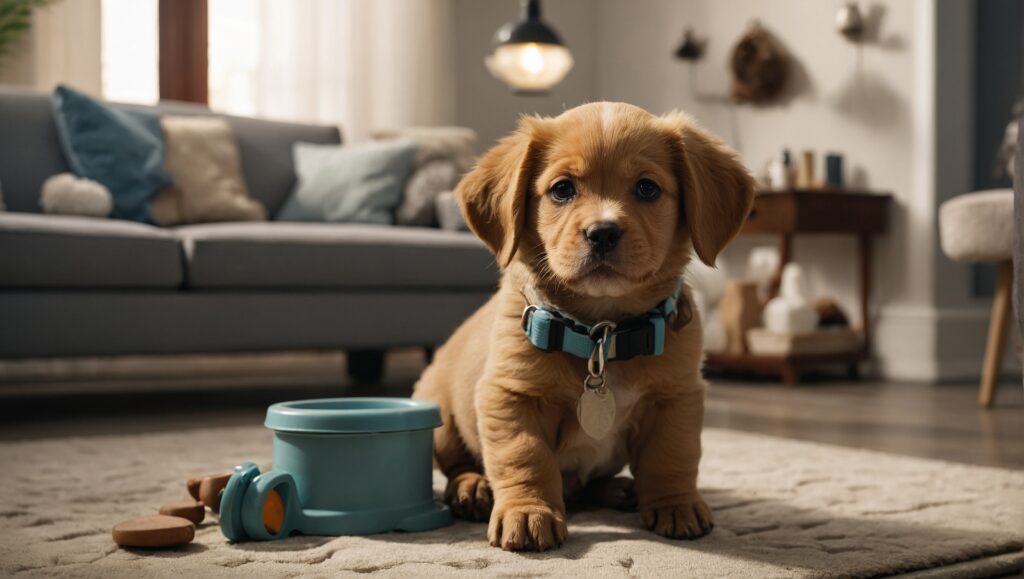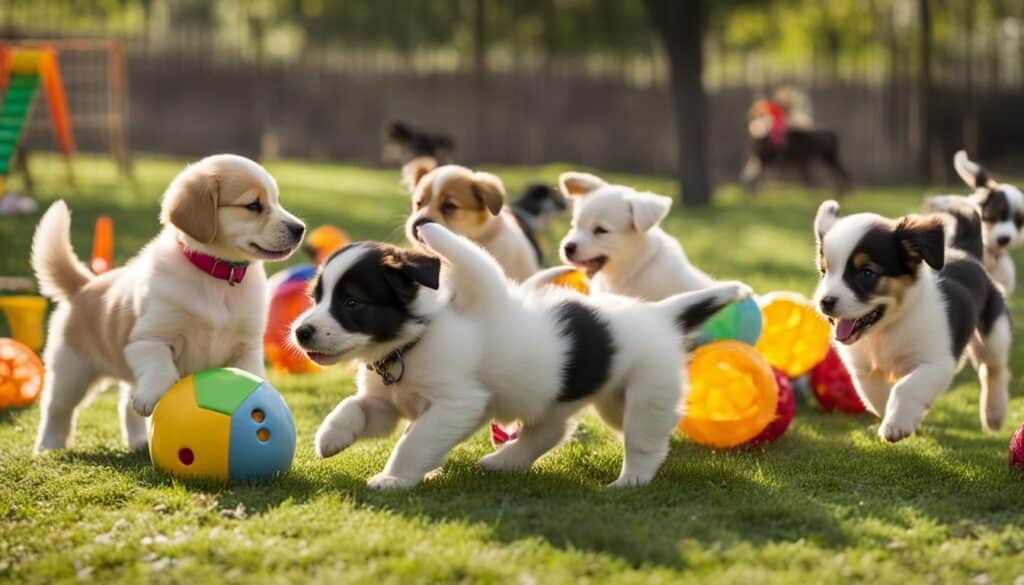Training your puppy is essential to their development, and using the proper techniques can make all the difference. One such technique that has gained popularity is positive reinforcement in puppy training. This approach focuses on rewarding desired behaviors rather than punishing unwanted behaviors, creating a positive and practical learning experience for your furry friend through positive reinforcement in dog training.
In this article, we will explore the concept of positive reinforcement training for puppies and how it can be a powerful tool in developing obedience and a strong bond between you and your pet. We will delve into the fundamental principles of positive reinforcement, its benefits, and how it can be implemented effectively in puppy training.
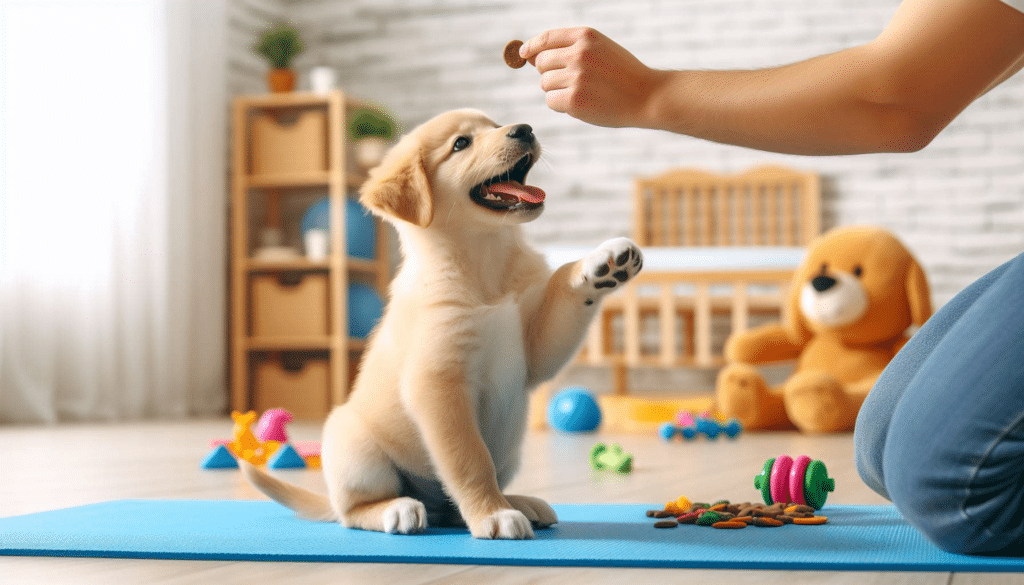
Key Takeaways:
- Positive reinforcement training focuses on rewarding desired behaviors instead of punishing unwanted behaviors.
- This training approach helps build a positive bond with your puppy and creates a positive learning experience.
- Implementing positive reinforcement methods, such as clicker training and shaping behavior, can strengthen desired behaviors in puppies.
- Verbal praise and rewards are crucial in reinforcing positive behaviors during training sessions.
- Positive reinforcement can help address misconceptions about training methods and foster a stronger connection with your pet.
What is Positive Reinforcement Training?
Positive reinforcement training is a method that focuses on rewarding desired behaviors rather than punishing unwanted behaviors. It utilizes treats, praise, or other rewards to encourage puppies to repeat desirable behaviors. By using positive reinforcement, trainers create a positive and rewarding learning experience for puppies, leading to effective training outcomes and a stronger bond between the trainer and the puppy.
Understanding Positive Reinforcement
Positive reinforcement operates on the principle that when a pleasant consequence follows a behavior, it is more likely to be repeated. In puppy training, positive reinforcement involves providing rewards such as treats, verbal praise, or playtime immediately after the puppy exhibits a desirable behavior. These rewards serve as motivators and reinforce the connection between the behavior and the positive outcome.
Benefits of Positive Reinforcement
Positive reinforcement training offers numerous benefits for puppies and their trainers. Firstly, it promotes a positive learning environment where puppies are encouraged to explore and engage in desired behaviors without fear of punishment. This approach fosters trust and strengthens the bond between the puppy and the trainer.
Additionally, positive reinforcement training enhances the puppy’s motivation to learn and cooperate. By receiving immediate rewards for their actions, puppies become eager to repeat rewarded behaviors, making the training process more effective and enjoyable for both parties.
Furthermore, positive reinforcement training helps develop appropriate behaviors and prevents the reinforcement of undesired ones. Instead of focusing on correcting mistakes, trainers emphasize and reward the desirable behaviors, gradually shaping the puppy’s behavior towards the desired outcome.
Four Quadrants of Operant Conditioning
Positive reinforcement training is based on the principles of operant conditioning, a learning theory that explains how behaviors are influenced by their consequences. The four quadrants of operant conditioning are:
| Quadrant | Definition | Example |
| Positive Reinforcement | Addition of a rewarding stimulus to increase the likelihood of a behavior being repeated | Giving a treat to a puppy for sitting on command |
| Negative Reinforcement | Removal of an aversive stimulus to increase the likelihood of a behavior being repeated | Stopping a loud noise when a puppy sits on command |
| Positive Punishment | Addition of an aversive stimulus to decrease the likelihood of a behavior being repeated | Giving a sharp “no” when a puppy bites |
| Negative Punishment | Removal of a rewarding stimulus to decrease the likelihood of a behavior being repeated | Taking away a toy when a puppy jumps on people |
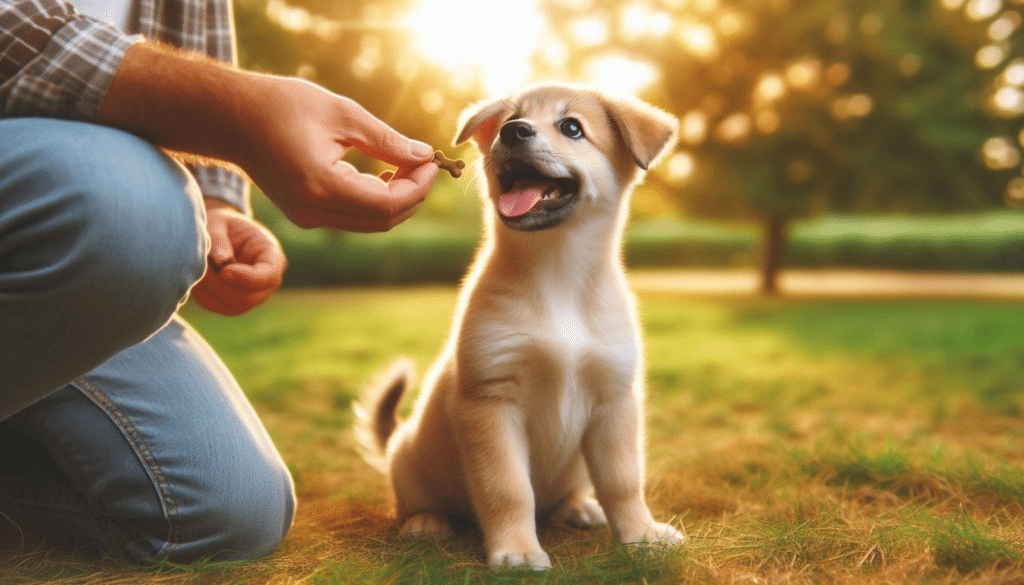
How to Use Positive Reinforcement in Puppy Training?
This section will discuss practical strategies for utilizing positive reinforcement in puppy training. Positive reinforcement methods are effective and humane ways to train your puppy, helping to strengthen their desired behavior while building a solid and positive bond with them. Implementing verbal praise and rewards is critical to positive reinforcement training, ensuring your puppy associates good behavior with positive experiences and encouragement.
Using Positive Reinforcement Methods
Positive reinforcement methods involve rewarding your puppy for exhibiting desirable behaviors and encouraging them to repeat those behaviors in the future. Two standard positive reinforcement techniques are clicker training and shaping behavior.
Clicker training involves using a clicker device that emits a distinct sound, followed by a reward, to indicate to your puppy that they have done something right. The clicker becomes a signal that reinforces positive behavior.
Shaping behavior involves breaking down complex tasks into smaller, manageable steps. You reward your puppy for completing each step, gradually shaping their behavior towards the desired outcome.
Strengthening Desired Behavior with Positive Reinforcement
Positive reinforcement is an effective method for strengthening desired behavior in puppies. By rewarding your puppy with treats, praise, or playtime when they exhibit the desired behavior, you reinforce their understanding that this behavior is desirable and should be repeated. Consistency and patience are crucial when using positive reinforcement to strengthen desired behavior.
For example, if you want to teach your puppy to sit, you can use positive reinforcement by giving them a treat when they sit on command. Over time, they will associate sitting with receiving a reward, making it more likely for them to perform the behavior consistently.
Implementing Verbal Praise and Rewards
Verbal praise and rewards are essential tools in positive reinforcement training. When your puppy exhibits the desired behavior, praise them verbally in a positive and enthusiastic tone. This verbal praise, accompanied by physical affection such as petting, helps reinforce the positive association with the behavior.
In addition to verbal praise, rewards such as treats, toys, or playtime can further reinforce positive behavior. These rewards should be given immediately after your puppy exhibits the desired behavior to establish a clear connection between their actions and the rewards they receive.
By consistently using verbal praise and rewards, you can effectively communicate to your puppy which behaviors are desired and encourage them to continue exhibiting them.
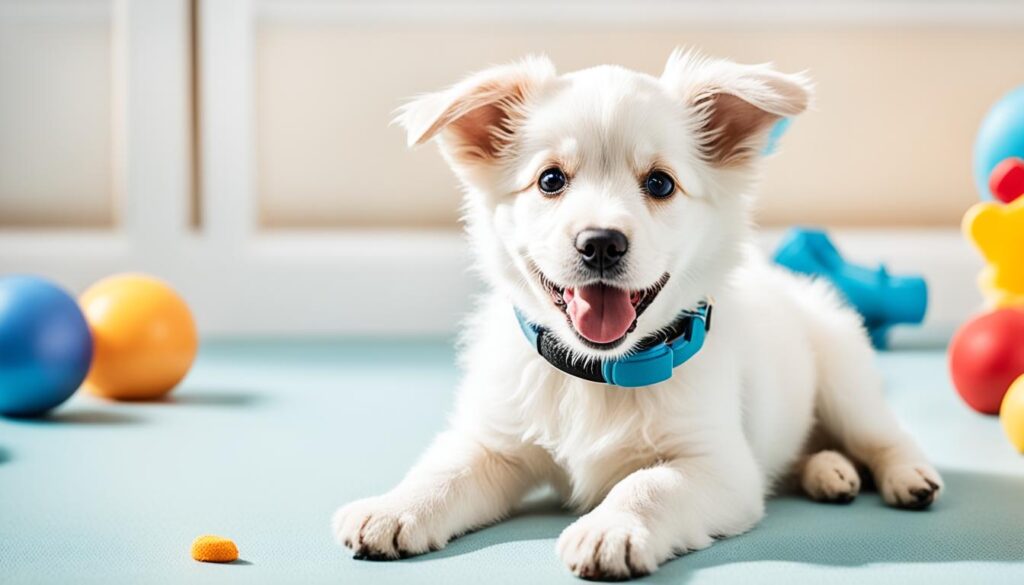
Why is Positive Reinforcement Effective in Training Puppies?
Positive reinforcement training is a highly effective method for training puppies. It helps them learn obedience and strengthens the bond between you and your furry friend. By utilizing positive experiences and rewards, you can create a positive learning environment that fosters a positive relationship with your puppy.
Building a positive bond with your puppy is essential for their overall development. When you use positive reinforcement techniques, such as treats, praise, and play, your puppy learns to associate good behavior with positive experiences. This strengthens the bond of trust and understanding between you and your puppy, making training sessions enjoyable for both of you.
Utilizing positive experiences in training sessions is crucial for creating a positive learning environment. When your puppy associates training with positive experiences, they are more likely to be motivated and engaged in learning. This leads to better retention of learned behaviors, making the training more effective and efficient.
Rewards play a vital role in positive reinforcement training. By rewarding your puppy for desired behaviors with treats, praise, or play, you reinforce those behaviors and encourage them to continue behaving in the desired way. This positive feedback helps your puppy understand what is expected of them and increases their motivation to learn and please you.
In conclusion, positive reinforcement training is practical for puppies because it builds a positive bond, utilizes positive experiences, and rewards desired behaviors. By implementing these techniques, you can create a harmonious and enjoyable training experience for your puppy while strengthening your relationship with them.
What are the Common Misconceptions About Positive Reinforcement Training?
Positive reinforcement training is a highly effective and widely used method for puppies. However, some common needs to be more accurate. By debunking this approach to these misconceptions, we can better understand the true nature and benefits of positive reinforcement training.
Distinguishing Positive Reinforcement from Positive Punishment
One misconception is the need for more clarity between positive reinforcement and positive punishment. While both terms involve using positive stimuli, they have distinct differences in their training methods and outcomes.
Positive reinforcement focuses on reinforcing desirable behaviors through rewards such as treats, praise, or playtime. This approach aims to encourage puppies to repeat these behaviors consistently. It creates a positive association with the desired behavior, making it more likely to occur.
On the other hand, positive punishment involves using aversive stimuli, such as scolding or leash corrections, to discourage unwanted behaviors. It aims to decrease the occurrence of these behaviors by associating them with negative consequences. Unlike positive reinforcement, positive punishment focuses on deterring undesired behaviors rather than reinforcing desired ones.
Addressing Negative Reinforcement in Training
Another misconception is the role of negative reinforcement in positive reinforcement training. Negative reinforcement involves the removal of aversive stimuli to increase the likelihood of a desired behavior. It is important to note that negative reinforcement is not a core component of positive reinforcement training.
Positive reinforcement training primarily relies on positive stimuli, such as rewards, to shape desirable behaviors. By focusing on rewards and positive experiences, trainers can foster a positive learning environment and strengthen the bond with their puppies.
To ensure a positive and practical training experience, addressing any negative reinforcement techniques that may inadvertently be used is crucial. This can be achieved by consulting with a professional trainer specializing in positive reinforcement methods or by educating oneself about the principles and techniques of positive reinforcement training.
By dispelling these common misconceptions, understanding the distinctions between positive reinforcement and positive punishment, and addressing negative reinforcement, we can embrace the true potential of positive reinforcement training in nurturing well-behaved and happy puppies.
How Can Positive Reinforcement Training Help Strengthen the Bond with Your Pet?
Positive reinforcement training goes beyond simply teaching your puppy basic commands. It also provides a unique opportunity to strengthen your bond and connection with your furry friend. Creating a positive environment that fosters trust and mutual understanding can enhance your pet’s learning and development while deepening the bond you share.
Creating a Positive Environment for Every Puppy
Creating a positive environment is critical to your puppy’s success in positive reinforcement training. This involves setting them up for success by removing any potential distractions or sources of anxiety. Providing a calm, comfortable, and consistent training environment creates a safe space for your pet to learn and grow.
You can also create a positive environment by incorporating play and socialization exercises into your training sessions. This adds an element of fun and strengthens the bond between you and your puppy. Remember, a positive and nurturing environment is essential for practical positive reinforcement training.
Tools and Techniques Used in Positive Reinforcement Puppy Training
Positive reinforcement training utilizes various tools and techniques to encourage and reinforce desired behaviors. One commonly used tool is a clicker, which produces a distinctive sound that signals your puppy that they have done something right. This sound is then followed by a treat or reward, reinforcing the behavior and allowing your puppy to associate the sound with positive outcomes.
Another technique used in positive reinforcement training is shaping behavior. This involves breaking down desired behaviors into smaller steps and rewarding your puppy for each successful attempt. By gradually shaping your desired behavior, you can set your puppy up for success and build their confidence.
Professional Insights on Effective Positive Reinforcement Training
To gain further insights into practical positive reinforcement training, we spoke with professional puppy trainers who shared their expertise. They emphasized the importance of consistency and patience in training and the need to adapt techniques to suit your puppy’s needs. Additionally, they highlighted the significance of positive reinforcement in building trust and strengthening the bond with your pet.
Professional trainers also stressed the value of clear communication and timing in positive reinforcement training. By providing immediate rewards for desired behaviors and redirecting or ignoring unwanted behaviors, you can effectively communicate your expectations to your puppy and ensure they understand what is being asked of them.
By incorporating these insights and techniques into your positive reinforcement training sessions, you can teach your puppy essential commands and create a lasting bond built on trust, understanding, and mutual respect.
FAQs
Q: What is positive reinforcement dog training?
A: Positive reinforcement dog training is a method where you teach your dog by rewarding their good behaviors. This approach encourages the dog to repeat those behaviors since they associate them with positive outcomes, such as treats, praise, or playtime. Unlike methods that rely on fear and anxiety, positive reinforcement fosters a loving and cooperative relationship between you and your dog.
Q: How can positive reinforcement in dog training help my dog learn commands more effectively?
A: Using positive reinforcement in dog training helps your dog understand what is expected of them in a stressing away. When your dog follows a command and is immediately rewarded, they are more likely to repeat this behavior. This method taps into the natural desires of every dog to please their owners and to receive rewards, making it an effective way to train your dog.
Q: What are some rewards I can use for positive reinforcement training?
A: Rewards can vary depending on what motivates your dog, but common examples include giving your dog a treat, verbal praise, petting, or playing with their favorite toy. It’s important to use rewards that are meaningful to your dog to encourage the repeat of desired behaviors.
Q: Is it possible to train any dog using positive reinforcement techniques?
A: Yes, positive reinforcement dog training is versatile and can be adapted to dogs of all ages, breeds, and personalities. Since the method focuses on rewarding your dog for good behavior, it creates a positive learning environment effective for training any dog.
Q: How does positive reinforcement compare to other dog training methods?
A: Positive reinforcement is one of the most humane and effective methods for training dogs. It contrasts with aversive techniques that use fear or punishment, which can lead to negative consequences such as anxiety or aggression in dogs. Training your dog with positive reinforcement fosters trust and understanding, which enhances the bond between you and your dog.
Q: How do professional dog trainers use positive reinforcement in dog training?
A: Professional dog trainers often use positive reinforcement for basic obedience and more complex behaviors. They may employ a variety of rewards and adjust their approach based on the individual dog’s preferences and motivations. Professionals also understand the timing and consistency needed when rewarding a dog to reinforce the desired behavior properly.
Q: Can positive reinforcement in dog training correct bad behavior?
A: Yes, positive reinforcement can be used to correct undesired behaviors by focusing on rewarding the opposite, desired behavior. For example, if a dog jumps on guests, you can use positive reinforcement training to teach your dog to sit to greet people instead. By rewarding your dog for sitting, you encourage them to choose sitting over jumping when greeting guests.
Q: What should I do if my dog does not respond to positive reinforcement training?
A: If your dog is not responding to positive reinforcement, it may be necessary to reassess the rewards to ensure they motivate your dog. Every dog has unique preferences, and what works for one dog might not work for another. Additionally, consider consulting with a professional dog trainer who can provide personalized advice and guidance based on your dog’s behavior and needs.
